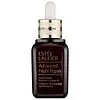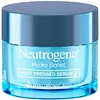What's inside
What's inside
 Key Ingredients
Key Ingredients

 Benefits
Benefits

 Concerns
Concerns

 Ingredients Side-by-side
Ingredients Side-by-side

Water
Skin ConditioningBifida Ferment Lysate
Skin ConditioningMethyl Gluceth-20
HumectantPEG-75
HumectantBis-PEG-18 Methyl Ether Dimethyl Silane
EmollientButylene Glycol
HumectantPropanediol
SolventCola Acuminata Seed Extract
Skin ConditioningHydrolyzed Algin
Pantethine
EmollientCaffeine
Skin ConditioningLecithin
EmollientTripeptide-32
Skin ConditioningEthylhexylglycerin
Skin ConditioningSodium Rna
Skin ConditioningBisabolol
MaskingGlycereth-26
HumectantSqualane
EmollientSodium Hyaluronate
HumectantOleth-3 Phosphate
Caprylyl Glycol
EmollientLactobacillus Ferment
Skin ConditioningOleth-3
EmulsifyingOleth-5
EmulsifyingAnthemis Nobilis Flower Extract
MaskingYeast Extract
Skin ConditioningCholeth-24
EmulsifyingHydrogenated Lecithin
EmulsifyingCeteth-24
CleansingTocopheryl Acetate
AntioxidantEthylhexyl Methoxycinnamate
UV AbsorberHexylene Glycol
EmulsifyingCarbomer
Emulsion StabilisingTriethanolamine
BufferingTrisodium EDTA
BHT
AntioxidantXanthan Gum
EmulsifyingPhenoxyethanol
PreservativeCI 14700
Cosmetic ColorantCI 19140
Cosmetic ColorantWater, Bifida Ferment Lysate, Methyl Gluceth-20, PEG-75, Bis-PEG-18 Methyl Ether Dimethyl Silane, Butylene Glycol, Propanediol, Cola Acuminata Seed Extract, Hydrolyzed Algin, Pantethine, Caffeine, Lecithin, Tripeptide-32, Ethylhexylglycerin, Sodium Rna, Bisabolol, Glycereth-26, Squalane, Sodium Hyaluronate, Oleth-3 Phosphate, Caprylyl Glycol, Lactobacillus Ferment, Oleth-3, Oleth-5, Anthemis Nobilis Flower Extract, Yeast Extract, Choleth-24, Hydrogenated Lecithin, Ceteth-24, Tocopheryl Acetate, Ethylhexyl Methoxycinnamate, Hexylene Glycol, Carbomer, Triethanolamine, Trisodium EDTA, BHT, Xanthan Gum, Phenoxyethanol, CI 14700, CI 19140
Water
Skin ConditioningDimethicone
EmollientGlycerin
HumectantCetearyl Olivate
Acrylates/Beheneth-25 Methacrylate Copolymer
Caprylic/Capric Triglyceride
MaskingSorbitan Olivate
EmulsifyingPhenoxyethanol
PreservativeDimethicone/Vinyl Dimethicone Crosspolymer
Skin ConditioningSynthetic Beeswax
Emulsion StabilisingSodium Polyacrylate
AbsorbentDimethicone Crosspolymer
Emulsion StabilisingParfum
MaskingSodium Hydroxide
BufferingTrehalose
HumectantDimethiconol
EmollientChlorphenesin
AntimicrobialTocopheryl Acetate
AntioxidantYeast Extract
Skin ConditioningCarbomer
Emulsion StabilisingSodium Hyaluronate
HumectantEthylhexylglycerin
Skin ConditioningSodium Laureth Sulfate
CleansingC12-14 Pareth-12
EmulsifyingHydroxymethoxyphenyl Decanone
Skin ConditioningSodium Metabisulfite
AntioxidantMoringa Oleifera Seed Extract
Skin ConditioningWater, Dimethicone, Glycerin, Cetearyl Olivate, Acrylates/Beheneth-25 Methacrylate Copolymer, Caprylic/Capric Triglyceride, Sorbitan Olivate, Phenoxyethanol, Dimethicone/Vinyl Dimethicone Crosspolymer, Synthetic Beeswax, Sodium Polyacrylate, Dimethicone Crosspolymer, Parfum, Sodium Hydroxide, Trehalose, Dimethiconol, Chlorphenesin, Tocopheryl Acetate, Yeast Extract, Carbomer, Sodium Hyaluronate, Ethylhexylglycerin, Sodium Laureth Sulfate, C12-14 Pareth-12, Hydroxymethoxyphenyl Decanone, Sodium Metabisulfite, Moringa Oleifera Seed Extract
 Reviews
Reviews

Ingredients Explained
These ingredients are found in both products.
Ingredients higher up in an ingredient list are typically present in a larger amount.
Carbomer is a polymer of acrylic acid. Its main role is to create a gel consistency.
A high amount of carbomer can cause pilling or balling up of products. Don't worry, most products contain 1% or less of carbomer.
Ethylhexylglycerin (we can't pronounce this either) is commonly used as a preservative and skin softener. It is derived from glyceryl.
You might see Ethylhexylglycerin often paired with other preservatives such as phenoxyethanol. Ethylhexylglycerin has been found to increase the effectiveness of these other preservatives.
Phenoxyethanol is a preservative that has germicide, antimicrobial, and aromatic properties. Studies show that phenoxyethanol can prevent microbial growth. By itself, it has a scent that is similar to that of a rose.
It's often used in formulations along with Caprylyl Glycol to preserve the shelf life of products.
Sodium Hyaluronate is hyaluronic acid's salt form. It is commonly derived from the sodium salt of hyaluronic acid.
Like hyaluronic acid, it is great at holding water and acts as a humectant. This makes it a great skin hydrating ingredient.
Sodium Hyaluronate is naturally occurring in our bodies and is mostly found in eye fluid and joints.
These are some other common types of Hyaluronic Acid:
Learn more about Sodium HyaluronateTocopheryl Acetate is AKA Vitamin E. It is an antioxidant and protects your skin from free radicals. Free radicals damage the skin by breaking down collagen.
One study found using Tocopheryl Acetate with Vitamin C decreased the number of sunburned cells.
Tocopheryl Acetate is commonly found in both skincare and dietary supplements.
Learn more about Tocopheryl AcetateWater. It's the most common cosmetic ingredient of all. You'll usually see it at the top of ingredient lists, meaning that it makes up the largest part of the product.
So why is it so popular? Water most often acts as a solvent - this means that it helps dissolve other ingredients into the formulation.
You'll also recognize water as that liquid we all need to stay alive. If you see this, drink a glass of water. Stay hydrated!
Learn more about WaterYeast extract is a silky, clear liquid derived from yeast (usually Saccharomyces cerevisiae or Torula yeast).
This ingredient has plenty of skin benefits:
Bioferments of yeast and soy have been found to reduce hyperpigmentation at low levels.
Due to its fatty acid content, this ingredient may not be fungal-acne safe.
Learn more about Yeast Extract